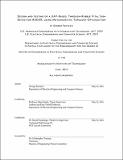Design and testing of a UAV-based, through-rubble vital sign detection RADAR using metaheuristic topology optimization
Author(s)
Pantazis, George, M. Eng. Massachusetts Institute of Technology
DownloadFull printable version (3.442Mb)
Other Contributors
Massachusetts Institute of Technology. Department of Electrical Engineering and Computer Science.
Advisor
Dina Katabi and Raoul Ouedraodo.
Terms of use
Metadata
Show full item recordAbstract
This thesis forms part of a larger effort at MIT Lincoln Laboratory to develop a micro-UAV based platform, capable of detecting survivors through rubble, under the funding of the New Technology Initiative (NTI) program. In support of this goal the thesis makes three distinct contributions. First, the operating environment of a disaster scenario is characterized. To do so, the electrical properties of different residential construction materials are determined and an analytical model for the behavior of a radar operating in this environment is developed. Second, preliminary efforts were made towards the miniaturization of the radar back-end by designing circuitry that generates the transmit waveform. Additionally an analog filter was developed to attenuate unwanted signals on the receive end. Lastly metaheuristic topology optimization was applied towards the design of antennas for the radar front-end. A novel, algorithmic extension to an established metaheuristic algorithm is demonstrated and tested. Additionally a new antenna parametrization based on Bezier curves is developed and evaluated against the established pixel-based parametrization.
Description
Thesis: M. Eng., Massachusetts Institute of Technology, Department of Electrical Engineering and Computer Science, June 2015. "May 2010." Cataloged from PDF version of thesis. Includes bibliographical references (pages 72-76).
Date issued
2015Department
Massachusetts Institute of Technology. Department of Electrical Engineering and Computer SciencePublisher
Massachusetts Institute of Technology
Keywords
Electrical Engineering and Computer Science.